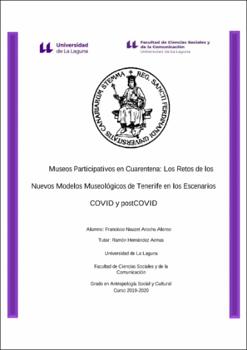Museos Participativos en Cuarentena: Los Retos de los Nuevos Modelos Museológicos de Tenerife en los Escenarios COVID y postCOVID
Date
2020Abstract
En 2020 se ha dado el caso de un estado de alarma producido por la pandemia del
COVID-19 que paralizó a casi toda la población mundial, generando incertidumbre, y que
nos hizo replantearnos muchos de nuestros modos de vida y de cómo debemos hacer las
cosas de aquí en adelante, en base a las nuevas normas sanitarias y distanciamiento social. En
este sentido, debemos pensar también en cómo nuestros hábitos lúdicos y de ocio se han
visto reducidos a actividades que podamos desarrollar en casa. Entonces ¿Qué pasa con el
resto de las actividades culturales de carácter presencial como por ejemplo las que ofrecen
los museos? Pues obviamente, al cerrar las vías convencionales de difusión y participación
en lugares como los museos, la única solución viable es adaptarse a la situación utilizando
medios adecuados para un distanciamiento efectivo y seguro, para lo que la Tecnología de la
Información y la Comunicación podrían prestar un gran servicio. Así pues, en esta
investigación nos centraremos en el análisis de la incidencia de las TICs en la actividad
normal de los museos tinerfeños, concretamente los casos del MUNA y el MHA. Así mismo
uno de los temas centrales de discusión más teórica, será el concepto de participación, como
se define, de qué se compone, y sobre todo los diferentes aspectos que se han visto obligados
a poner en marcha en este contexto del COVID-19, y el futuro inmediato post-COVID-19 In 2020 there has been the case of a state of alarm produced by the COVID-19
pandemic that paralyzed almost the entire world population, generating uncertainty, and that
made us rethink many of our ways of life and how we should do things from now on, on the
basis of new health standards and social distancing. In this sense, we must also think about how our leisure habits have been reduced to activities that we can develop at home. So what
about the rest of the cultural activities in person, such as those offered by museums? Well it is
simple, by closing the conventional channels of diffusion and participation in places like
museums, the only viable solution is to adapt to the situation using adequate means for an
effective and safe distance, for which Information and Communication Technology could
provide a great service. Thus, in this research we will focus on the analysis of the incidence
of ICTs in the normal activity of museums in Tenerife, specifically the cases of MUNA and
MHA. Likewise, one of the central topics of more theoretical discussion will be the concept
of participation, as it is defined, what it is composed of, and especially the different aspects
that have been forced to put in place in this context of COVID-19, and the immediate future
post-COVID-19.





